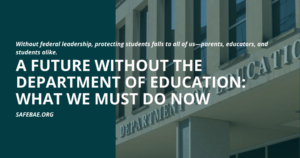A Future Without the Department of Education: What We Must Do Now
Without federal leadership, protecting students falls to all of us—parents, educators, and students alike.
Written By Founding Executive Director – Shael Norris
Protecting Students in a Post-Department of Education Era
As we begin to process the possibility of a country without the Department of Education, now is the time to double down on protecting student safety. If we can’t count on federal protections to safeguard students, then it falls to us — parents, educators, students, and communities — to act. The children whose safety is now at risk may be near adulthood by the time any future protections are restored. In the meantime, we have a moral obligation to work with them — to empower them — to equip them with knowledge, support, and a voice in the places they spend most of their time.
Schools Must Lead with Prevention and Trauma-Informed Policies
Nothing prevents school boards and administrators from adopting comprehensive, trauma-informed policies today — including healthy relationship education as a central part of a robust social and emotional learning curriculum. If administrators are now expected to shoulder the overwhelming responsibility of supporting students experiencing abuse — often at the hands of their peers — then we must equip them with the tools, training, and funding to respond effectively.
The CDC has already sounded the alarm: rates of sexual violence and suicidal ideation are rising, especially among teen girls. And yet, we continue to overlook even the clearest, most accessible opportunities for intervention — education — let alone engage the harder, more urgent ones. Too often, we ignore the students who cause harm — engaging them only to punish them — despite knowing that many have never been taught about consent or boundaries in the first place. Why are we still surprised when young people violate rules they’ve never had the chance to learn?
This is a crisis. A preventable, life-threatening crisis. The dismantling of federal protections cannot become an excuse for inaction. We can no longer rely on the hollow threat of losing federal funding to force schools to do the right thing. That was never enough — and it’s certainly not now.
Students and Parents: Your Voices Are Critical
So here is the challenge: We call on school administrators, from K–12 to higher education, to immediately review, revise, and strengthen their sexual misconduct policies. Too many schools have no policy at all. And even when policies exist, they are often inaccessible, outdated, and — almost always — not trauma-informed. Policy change takes work. It requires commitment, collaboration, and representation from every corner of our school communities. But it must begin now — and it must come from us.
To student leaders — and to those just discovering your power — we urge you: show up. Attend school board meetings. Demand time at the podium. Make the case for your safety, and insist on being part of the solution. I promise you, most school boards rarely hear directly from their students. Your voice matters. Your leadership is needed.
To parents and caregivers: many of us were never taught about consent, healthy relationships, or student rights. But we can change that for our children. No matter how politicized Title IX has become — dragged into debates that cruelly ignore even the most basic dignity of our children — all parents can agree on this: we want our kids to be safe. We want to know that when they walk into school, they won’t be harmed by peers or by the adults tasked with educating them — and that they will protected in school when it matters most. We can disagree on many things, but not this. Keeping our children safe must be a shared commitment.
Real Change Starts at Home — And We Have the Tools
I know I personally feel powerless watching what’s happening at the federal level. But I also know that real change starts at home and in our communities. We can still protect our kids. We can still choose care, accountability, and safety. And most importantly, you are not alone in trying to figure out how to fight for safety in schools. No one can do everything, but everyone can do something — and there is a library of survivor-created tools to help you speak up in whatever way you can. Whether you’re a parent, a student, or a school leader, there’s a place for you in this work.
We’re not waiting for the system to catch up. We’re building something better.
Reach out directly at info@safebae.org


